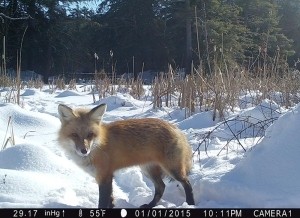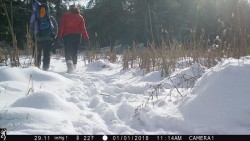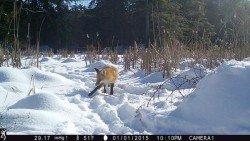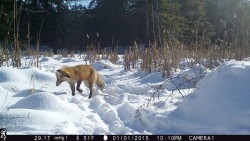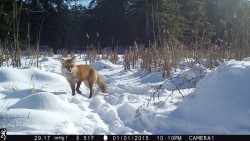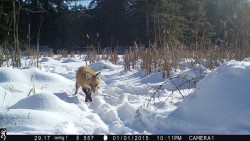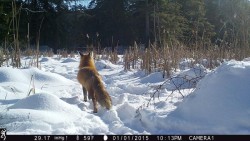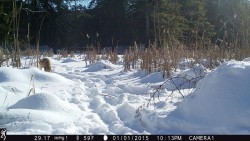Many wild animals have a fondness for edge habitat, but foxes especially so. It could be the edge of a meadow, or a lake, or the transition where one forest type meets another. These areas offer some combination of good hunting/foraging opportunities and security.
Most wild animals value efficiency – survival depends on it – but foxes especially so. They readily follow paths and wood roads from point A to point B. Even their gait is efficient – the tracks as straight and true as a string of pearls.
Foxes are curious animals, so they tend to investigate disturbances. Burn a pile of brush in fox country and soon thereafter you’ll find tracks in the ashes. Dump a pile of manure in a field and it too will soon be covered in tracks.
We used one, or two, or maybe all three of these proclivities to capture these nice winter images of a red fox. The camera was set up on a frozen stream where it entered a frozen swamp – our “edge.” The site was basically a winter version of a farm road through a hedgerow, in that the area was a path to and through good edge habitat.
The human tracks were themselves a trail, but they were also a disturbance. In the first shot you see the human figures leaving the camera. (Note how the date, time, and temperature stamp malfunctioned somewhere between the human shot and the fox shot – needless to say, ignore that information.) In the next shot on the memory card (I suspect it was later that day, but can’t tell for sure because of the malfunction) you see the fox coming in on the human tracks. Maybe it was simply the easy walking that attracted the fox to follow the same route, though I suspect that there was a curiosity factor at play, too, fueled by Pavlovian reinforcement. For the past three months in this rural area, deer hunters have been leaving tracks that end in gut piles, trappers leaving tracks that end in dead muskrats, ice-fishermen leaving tracks that lead to gill-snagged perch and discarded bait-fish. I’m sure none of this was lost on the fox.


